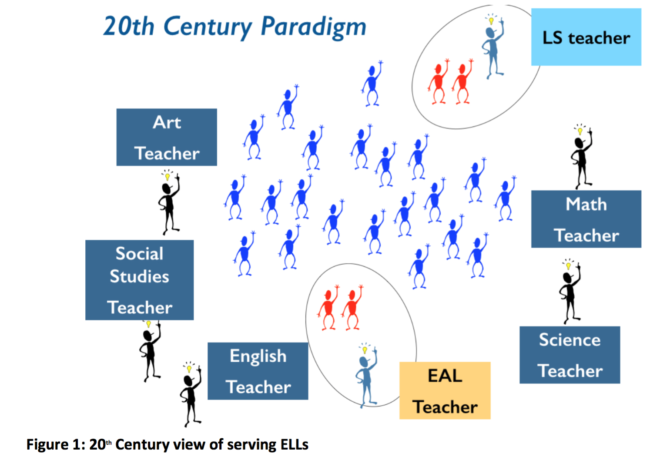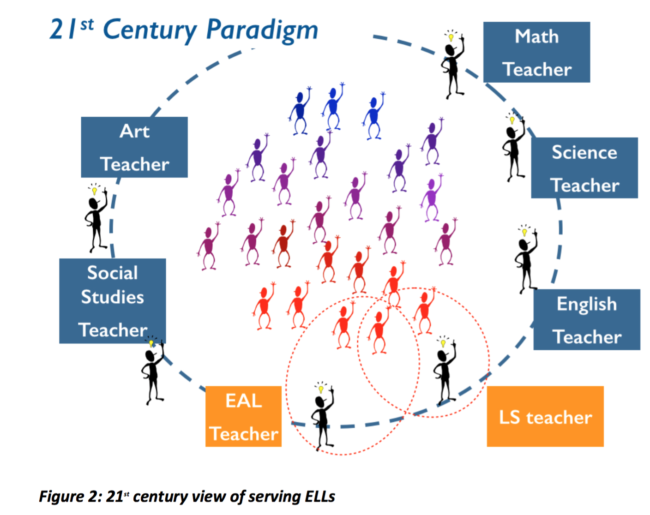This article by Jon Nordmeyer, originally published in the EARCOS Tri-Annual Journal, Winter 2015, is one of two articles that will close out the Collaboration for ELs series.
Teaching can be a lonely profession. It can be said that, as teachers, our
greatest hope and greatest fear is that someone, someday will discover what
actually happens in our classrooms. There are days when we witness a miracle of creation and joy of discovery, and lament that no one else was there to share it with us. And then there are days of catastrophic failure: turn off the lights, close the door and go home. By making private practice public, professional collaboration holds the promise of realizing our hopes and eroding our fears.
Fortunately, collaboration is emerging as a new norm in today’s international schools.
When educators plan, teach and inquire together, we model the 21st century
learning skills we hope to develop in our students. However, professional
cooperation requires both will and skill; making the “transition from rigid
individualism to an acceptance of interdependence” requires effort (Garmston &
Wellman, 2013). Unfortunately, professional collaboration is neither easy nor natural in most schools, which are historically isolating institutions haunted by the “legacy of the one-room schoolhouse” (Glickman, 2003). Teachers need to see the value in working together, and schools need to dedicate the time to develop the tools and processes for effective collaboration.
Structural and cultural support for collaboration can engage all learners in the core curriculum while developing essential academic language and literacy skills. In thriving learning communities, the important work of collaboration can provide valuable opportunities to not only ignite student learning but also fuel teacher growth. Barth asserts: “One incontrovertible finding emerges from my career spent working in and around schools: The nature of relationships among the adults within a school has a greater influence on the character and quality of that school and on student accomplishment than anything else” (2006).
Collaboration is not an end in itself, but in order to realize the full potential of professional cooperation to improve student learning and transform schools, we need to understand and nurture collaborative cultures and structures.
Supporting English language learners
The evolution of English as an Additional Language (EAL) programs has established a new role for EAL teachers, and new opportunities for collaboration. Since English language learners (ELLs) need to develop content and language skills at the same time, EAL support has been increasingly viewed as an integrated process rather than a discrete discipline. When disciplinary boundaries overlap, it introduces powerful new ways of engaging with colleagues (Nordmeyer, 2010). Many schools have moved towards a program of sheltered immersion or inclusion in the past decade (Honigfeld & Dove, 2010) to meet the needs of ever-growing numbers of ELLs.
Greater integration and collaboration challenges teachers to view ELLs along a developmental continuum of academic English, which reframes the role of EAL teachers. This evolution represents a shift away from a 20th century paradigm (Figure 1) of viewing ELLs as a small, separate group of students who are the responsibility of EAL teachers. In other words, ELLs were considered a “problem” for the EAL teacher to “fix” so they could return to the mainstream to learn the “regular” curriculum with other students.

In the in the 21st century paradigm (Figure 2), all teachers share responsibility for all students. From this perspective, ELLs are viewed along a continuum on which all students are developing academic English proficiency. ELLs are not different in kind, but in degree, with a wide variation of English proficiency, and continue to move along this developmental continuum (Freeman, 2005). Davison, Leung, and Mohan (2001) observe: “differences notwithstanding, both ESL learners and native speakers are learning language for academic purposes, and both groups are using language to learn” (p. 218). When we recognize our collective responsibility to serve all English language learners, collaboration is not a luxury but a necessity.

As EAL programs in international schools continue to become more collaborative, EAL teachers can also serve as team members and professional resources. This paradigm shift can be seen in changing hallway conversations which reflect shared ownership.
- The 20th century paradigm sounds like: “Isn’t Ji Won one of your students? He was really lost today.” (implication: you need to fix it).
- The 21st century paradigm sounds like: “Can we figure out how to help Ji Won? I wasn’t really reaching him today” (implication: our collaboration can support this student’s learning).
In many international schools, in addition to pull-out classes focused on English language development, EAL teachers offer in-class or “push in” support. Yet without time and structures to support co-planning and co-assessing, the EAL teacher is too often relegated the de-facto role of the “language whisperer,” a silent partner who shadows students and stays out of the way. This restricted version of collaboration limits the opportunities for both teachers to scaffold language and content learning or expand the use of formative assessment to move learners forward.
Building specific tools for collaboration allows EAL teachers and mainstream colleagues to work in concert to support student learning. Working agreements can help to build relational trust by articulating some of the assumptions we make about one another’s classroom or teaching style. For example, some teachers are comfortable with a co-teaching partner using time strategically and only joining for part of a class, while others prefer a commitment to the entire lesson.
Some teachers relish a colleague’s impromptu restatement of a concept by drawing a concept map on the whiteboard, others prefer this explanation shared with a small group later. Another useful tool is a “menu” of support options and co-teaching structures; this allows both teaching partners to expand the realm of what is possible and provides a convenient tool for co-planning.
While finding time to plan together is a challenge in every school, electronic tools such as shared calendars, Google docs and collaborative curriculum maps on Atlas can support asynchronous co-planning to complement face-to-face meetings. These structures can help to establish a trusting relationship by facilitating the intentional examination of how teachers work together and revisiting these tools periodically helps to maintain mutual respect.
Jon’s Bio
Jon Nordmeyer has been an international educator and consultant for 25 years. He has taught in Quito, The Hague, Taipei, Istanbul, Shanghai and Bangkok and has presented at international conferences in Africa, Asia, Europe and South America. He has written for International Schools Journal and Journal of Staff Development, and co-edited the Integrating Language and Content (TESOL 2010). He is the International Programs Director at WIDA and serves on the editorial review board of Globally Informed, a peer-reviewed journal for international educators. Jon earned a BA in Classical Archaeology from Dartmouth College and MA in TESOL from School for International Training. He is pursuing his PhD in Educational Leadership and Policy Analysis at the University of Wisconsin-Madison.
Garmston, B. & Wellman, B. (2013). The Adaptive School: A Sourcebook for Developing Collaborative Groups. Rowman and Littlefield.
Glickman C. (2003). Holding Sacred Ground: Essays on Leadership, Courage and Endurance in Our Schools. Jossey-Bass.
Gray, B. (1989). Collaborating: Finding Common Ground for Multiparty Problems. Jossey-Bass.
Honigsfeld, A. and Dove, M. (2010). Collaboration and Co-Teaching: Strategies for English Learners. Corwin.
Nordmeyer (2010). “At the Intersection of Language and Content” in Nordmeyer & Barduhn, S. (eds.) Integrating Language and Content. TESOL.

